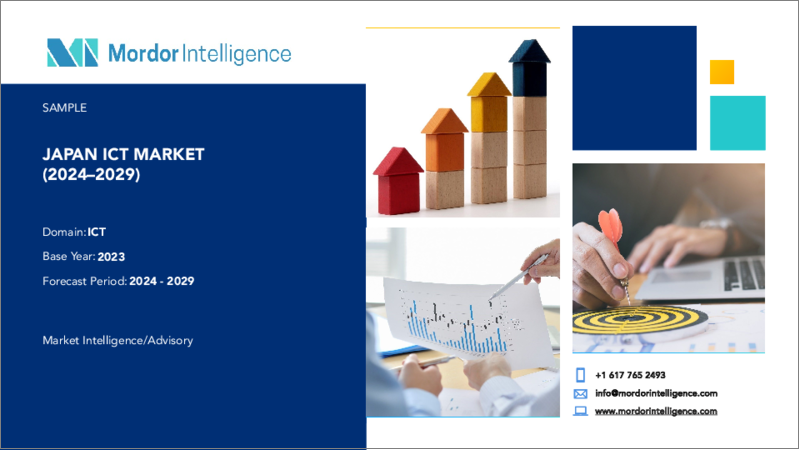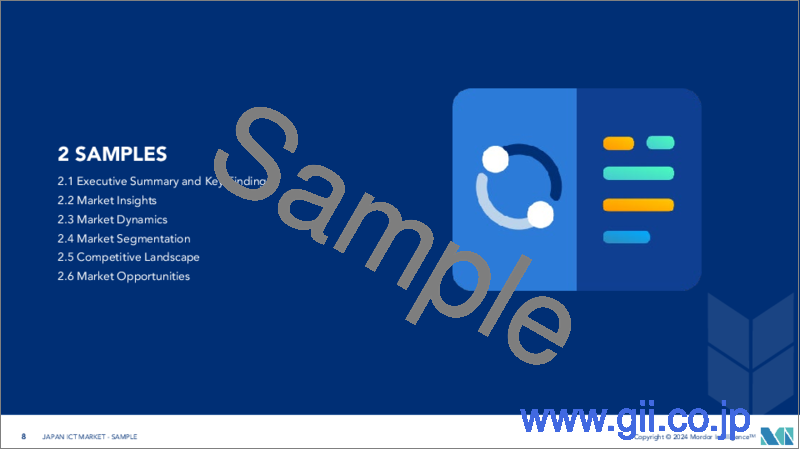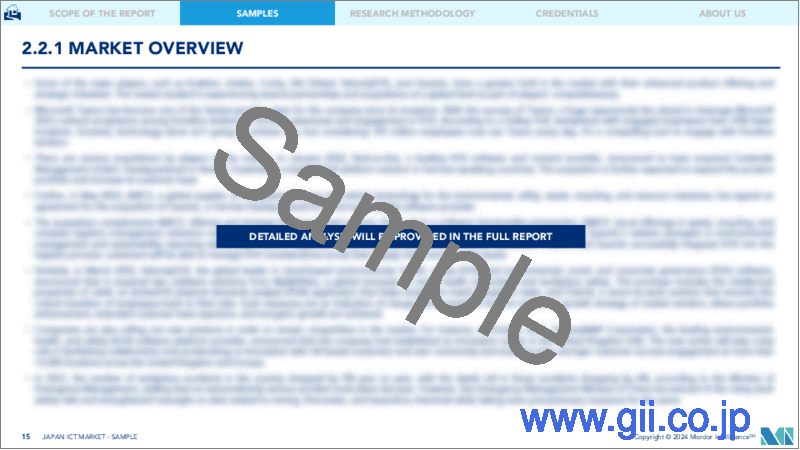|
|
市場調査レポート
商品コード
1200898
日本のICT市場- 成長、動向、予測(2023年~2028年)Japan Ict Market - Growth, Trends, and Forecasts (2023 - 2028) |
||||||
|
● お客様のご希望に応じて、既存データの加工や未掲載情報(例:国別セグメント)の追加などの対応が可能です。 詳細はお問い合わせください。 |
|||||||
| 日本のICT市場- 成長、動向、予測(2023年~2028年) |
|
出版日: 2023年01月23日
発行: Mordor Intelligence
ページ情報: 英文 100 Pages
納期: 2~3営業日
|
- 全表示
- 概要
- 目次
日本のICT市場は、予測期間中に11.25%のCAGRで推移すると予想されています。
デジタル技術、AI、ロボティクス、サイバーセキュリティ、ヘルスケアITの重視の高まりが、市場の成長を後押ししています。
主なハイライト
- 情報通信技術(ICT)とは、情報へのアクセス、送信、処理、保存のためのコンピュータ、通信、規制政策の融合です。
- 日本では、家電、軍事、農業、建設など多様な産業でIoTベースのデバイスの導入が進んでいることが、主に日本のICT市場の成長を牽引しています。
- 日本には、ソニー、パナソニック、富士通、NEC、東芝などの重要なICT組織があり、これがさらに、日本をICTの主要拠点として拡大させる上で大きな役割を担っています。また、ハイエンドで先進的なインフラを維持するための政府支出の増加や、日本における多数の近代化・強化プロジェクトの適切な展開も、市場の成長を促進しています。
- オンライン行政サービスに対する市民の参加、自己評価、フィードバックなど、地域の電子政府プロジェクトの開発を重視するE-Japan戦略の急速な進展は、今後の日本のICT市場の成長を促進しています。
- しかし、データのデジタル化や高速インターネットの普及に伴い、システムに不正にアクセスして金銭や知的財産、個人情報を盗んだり、重要インフラを制御するシステムを破壊したりするなどの犯罪が発生しています。
- COVID-19の大流行は、日本の技術・通信分野に多大な影響を及ぼしました。このパンデミックは、ヘルスケア、教育、オンライン決済、製品・サービスのオンライン提供、在宅勤務など、いくつかの分野やサービスのデジタル化を加速させました。通信業界は、携帯電話や家庭用ブロードバンド接続への大きな需要によって強化されました。
日本のICT市場の動向
デジタル技術の探求と導入の必要性の高まりと取り組み
- 日欧産業協力センターによると、日本はビジネス環境と社会が安定しており、ICTインフラ、通信技術、教育、ヘルスケアなどのインフラやサービスの質が高いことが特徴であるとされています。
- 日本政府(GoJ)は、民間企業のデジタル移行を加速させ、新興の中小企業を支援するための取り組みを行っています。日本政府は2021年に経済産業省と総務省の主導で、組織内のデジタル変革を促進するためのガイドラインを発表し、特に中小企業を対象とした指針を示しました。同様に、AI、サイバーセキュリティ、セキュアなクラウドサービスの導入に関するガイドラインも同年発表されました。
- 2022年11月、デジタルインフラを提供するエクイニクスは、新しいデータセンターに1億1500万米ドルを投資し、日本におけるデジタルインフラの拠点を拡大すると発表しました。この新しいデータセンターは、世界なネットワークおよびクラウドサービスプロバイダーと企業の接続性を強化し、日本の成長するデジタル経済への拡張と強化を可能にする予定です。
- さらに、日本政府は2022年6月、デジタル化推進を目的とした基本方針に従い、2030年末までに無線ネットワークを拡充し、国内人口の99%をカバーすることを発表し、海底ケーブルも2025年末までに日本全国で完成させる予定です。
IT・通信産業が市場成長を牽引
- 日本政府のデジタル庁は、中央省庁、地方公共団体を問わず、クラウドサービスの活用を推進しています。例えば、2022年10月、デジタル庁は日本政府の各機関が「ガバメントクラウド」サービスを採用することを発表しました。
- 市場の主要企業は、IT分野におけるクラウドインフラストラクチャの需要増に対応するため、強化されたクラウドサービスを提供しています。例えば、富士通は2022年10月、パブリッククラウドを通じて新興のコンピューティング技術へのアクセスを顧客に提供する「Fujitsu Computing as a Service」(CaaS)を日本市場に投入し、2023年度には世界展開を開始すると発表しました。
- さらに、6Gシステムの導入により、5Gの性能を超える高速・大容量・低遅延性能を同時に実現し、100GHz以上のサブテラヘルツ帯などの新しい高周波帯を使用、空・海・宇宙での通信範囲を拡大し、超低消費電力と低コストの通信を両立することが期待されます。
- 2022年6月、日本の通信機器メーカーであるNEC、富士通、ノキアが共同で、2030年の6G商用サービス開始を目標に、新しい移動通信技術の実証実験を開始しました。
- 経済産業省によると、2020年の日本の情報技術(IT)分野への民間投資額は約13兆円です。今後数年でさらに成長し、約13.9兆円に達すると予想されています。
日本のICT市場の競合他社分析
日本のICT市場は、複数の世界企業の存在により、非常に競争が激しくなっています。これらの企業は、日本全国で顧客基盤をさらに拡大し、有機的および無機的な成長戦略を採用することに注力しています。各社は、市場シェアと収益性を高めるために、戦略的な協力イニシアティブ、買収、製品投入を活用しています。
- 2022年6月、ICTプロバイダーの富士通は、顧客管理サービスを提供するセールスフォース・ジャパンと、保険分野向けの新しいデジタルソリューションの開発で提携すると発表しました。
- 2022年 6月、日立製作所は、日本におけるデータ保存と個人情報保護に関する法律を満たすよう設計されたソフトウェア・クラウド・サービスを開始することを発表しました。このサービスにより、日立が管理・運営し、現地のプライバシーおよびセキュリティ要件を満たすように設計された日本国内のデータセンターに、お客様のデータを保管することが可能になります。
その他の特典
- エクセル形式の市場予測(ME)シート
- アナリストによる3ヶ月間のサポート
目次
第1章 イントロダクション
- 調査の前提条件と市場の定義
- 調査対象範囲
第2章 調査手法
第3章 エグゼクティブサマリー
第4章 マーケットインサイト
- 市場概要
- 産業バリューチェーン分析
- 産業の魅力度-ポーターのファイブフォース分析
- 新規参入業者の脅威
- 買い手/消費者の交渉力
- 供給企業の交渉力
- 代替品の脅威
- 競争企業間の敵対関係
第5章 市場力学
- 市場促進要因
- デジタル技術やイニシアチブを模索し、採用するニーズの高まり
- 市場の課題
- データ漏えいの発生率の増加とインフラ不足
- COVID-19によるIT投資への影響
第6章 主要なテクノロジー投資
- クラウド技術
- 人工知能
- サイバーセキュリティ
- デジタルサービス
第7章 市場セグメンテーション
- タイプ別
- ハードウェア
- ソフトウェア
- ITサービス
- 通信サービス
- 企業規模別
- 中小企業
- 大企業
- 業界別
- BFSI
- IT・通信
- 政府機関
- 小売・eコマース
- 製造業
- エネルギー・公益事業
- その他の業界別
第8章 競合情勢
- 企業プロファイル
- Fujitsu Limited
- Hitachi Ltd
- TIS Inc
- IBM Japan Ltd
- NEC Corporation
- ITOCHU Techno-Solutions Corporation(ITOCHU Corporation)
- Panasonic Corporation
- Sony Corporation
- Salesforce
- SCSK Corporation(Sumitomo Corporation).
第9章 投資分析
第10章 市場の将来
The Japanese ICT market is anticipated to record a CAGR of 11.25% over the forecast period. The growing emphasis on digital technology, AI, robotics, cyber security, and healthcare IT is driving the growth of the market.
Key Highlights
- Information and communications technology (ICT) is the fusion of computer, communications, and regulatory policies for information access, transmission, processing, and storage.
- In Japan, the increasing adoption of IoT-based devices across diverse industries, including consumer electronics, military, agriculture, and construction, is primarily driving the growth of the ICT market in Japan.
- Japan is home to significant ICT organizations, including Sony, Panasonic, Fujitsu, NEC, and Toshiba, which is further playing a major role in the expansion of Japan as a major hub for ICT. Additionally, the rising government expenditures on maintaining the high-end and advanced infrastructures, along with the proper development of numerous modernization and enhancement projects in the country, are also propelling market's growth.
- The rapid growth of the E-Japan strategy that emphasizes the development of local e-governance projects, including participation of citizens, self-evaluation, and feedback for online government services, is promoting the growth of the Japanese ICT market in the future.
- However, the digitalization of data and increasing use of high-speed internet have led to crimes, including illegally gaining access to systems to steal money, intellectual property, or private information or to disrupt systems that control critical infrastructure.
- The COVID-19 pandemic had a tremendous impact on the Japanese technology and telecommunications sector. The pandemic has accelerated the digitalization of several sectors and services, including healthcare, education, online payments, product and service delivery online, and work from home. The telecommunications industry was strengthened by the substantial demand for mobile and residential broadband connections.
Japan ICT Market Trends
Rising need to explore and adopt digital technologies and initiatives
- According to EU-Japan Center for Industrial Cooperation, Japan is characterized by the stability of its business environment and society as well as by the quality of infrastructure and services, including ICT infrastructures, communication technologies, education, and healthcare.
- The Government of Japan (GoJ) is taking initiatives to accelerate the digital transition of the private sector and support emerging SMEs. The Japanese government published guidelines in 2021 under the initiative of the METI and the MIC to promote digital transformation within organizations, with guidance specifically targeting SMEs. Similarly, guidelines for AI, cybersecurity, and secure cloud services implementation were published in the same year.
- In November 2022, Equinix, a digital infrastructure provider, announced the expansion of its digital infrastructure footprint in Japan by investing USD 115 million in a new data center. The new data center will strengthen connectivity for global network and cloud service providers and enterprises, allowing them to scale and empower Japan's growing digital economy.
- Moreover, in June 2022, according to its basic policy aimed at promoting digitalization, the Japanese government announced that it would expand wireless networks to cover 99% of the country's population by the end of 2030, and seabed cables are planned to be completed across Japan by the end of 2025.
IT and Telecommunication Industry to Drive Market Growth
- The Government of Japan's Digital Agency promotes cloud services utilization for both central government and local government offices. For instance, in October 2022, the Digital Agency announced that the Government of Japan agencies would adopt "Government Cloud" services.
- Significant players in the market are providing enhanced cloud services in order to meet the rising demand for cloud infrastructure in the IT sector. For instance, in October 2022, Fujitsu announced the launch of "Fujitsu Computing as a Service" (CaaS) to deliver customers access to emerging computing technologies through the public cloud to the Japanese market, with a global rollout to follow in fiscal 2023.
- Moreover, the introduction of the 6G system is expected to exceed the performance of 5G and simultaneously provide high-speed, large capacity, and low latency capabilities, use new high-frequency bands such as sub-terahertz bands above 100 GHz, expand communication coverage in the sky, at sea, and in space, and enable both ultra-low-power consumption and low-cost communications.
- In June 2022, Japanese telecom equipment manufacturers NEC and Fujitsu, and Nokia collaborated to conduct experimental trials of new mobile communications technologies for the targeted commercial launch of 6G services by 2030.
- According to METI (Japan), in 2020, the volume of private investment in the Japanese information technology (IT) sector was around JPY13 trillion. The market is expected to grow further and reach approximately JPY13.9 in the next few years.
Japan ICT Market Competitor Analysis
The Japanese ICT market is highly competitive, owing to the presence of several global players. These players focus on further expanding their client base across the country and adopting organic and inorganic growth strategies. The companies leverage strategic collaborative initiatives, acquisitions, and product launches to increase market share and profitability.
- In June 2022, Fujitsu, an ICT provider, announced its partnership with Salesforce Japan, a customer relations management service company, to develop new digital solutions for the insurance sector.
- In June 2022, Hitachi announced the launch of a sovereign cloud service in Japan designed to meet local data storage and privacy laws. The service would enable customer data to be stored in data centers in Japan managed and operated by Hitachi and designed to meet local privacy and security requirements.
Additional Benefits:
- The market estimate (ME) sheet in Excel format
- 3 months of analyst support
TABLE OF CONTENTS
1 INTRODUCTION
- 1.1 Study Assumptions and Market Definitions
- 1.2 Scope of the Study
2 RESEARCH METHODOLOGY
3 EXECUTIVE SUMMARY
4 MARKET INSIGHTS
- 4.1 Market Overview
- 4.2 Industry Value Chain Analysis
- 4.3 Industry Attractiveness - Porter's Five Force Analysis
- 4.3.1 Threat of New Entrants
- 4.3.2 Bargaining Power of Buyers/Consumers
- 4.3.3 Bargaining Power of Suppliers
- 4.3.4 Threat of Substitute Products
- 4.3.5 Intensity of Competitive Rivalry
5 MARKET DYNAMICS
- 5.1 Market Drivers
- 5.1.1 Rising need to explore and adopt digital technologies and initiatives
- 5.2 Market Challenges
- 5.2.1 Growing Incidence of Data Breaches and Lack of Supporting Infrastructure
- 5.3 Impact of COVID-19 on the IT Spending
6 KEY TECHNOLOGY INVESTMENTS
- 6.1 Cloud Technology
- 6.2 Artificial Intelligence
- 6.3 Cyber Security
- 6.4 Digital Services
7 MARKET SEGMENTATION
- 7.1 By Type
- 7.1.1 Hardware
- 7.1.2 Software
- 7.1.3 IT Services
- 7.1.4 Telecommunication Services
- 7.2 By Size of Enterprise
- 7.2.1 Small and Medium Enterprises
- 7.2.2 Large Enterprises
- 7.3 By Industry Vertical
- 7.3.1 BFSI
- 7.3.2 IT and Telecom
- 7.3.3 Government
- 7.3.4 Retail and E-commerce
- 7.3.5 Manufacturing
- 7.3.6 Energy and Utilities
- 7.3.7 Other Industry Verticals
8 COMPETITIVE LANDSCAPE
- 8.1 Company Profiles
- 8.1.1 Fujitsu Limited
- 8.1.2 Hitachi Ltd
- 8.1.3 TIS Inc
- 8.1.4 IBM Japan Ltd
- 8.1.5 NEC Corporation
- 8.1.6 ITOCHU Techno-Solutions Corporation (ITOCHU Corporation)
- 8.1.7 Panasonic Corporation
- 8.1.8 Sony Corporation
- 8.1.9 Salesforce
- 8.1.10 SCSK Corporation (Sumitomo Corporation).




